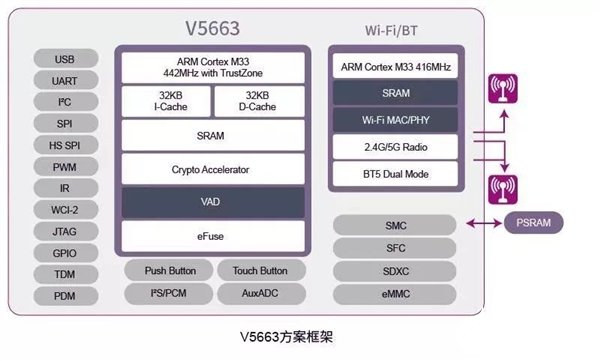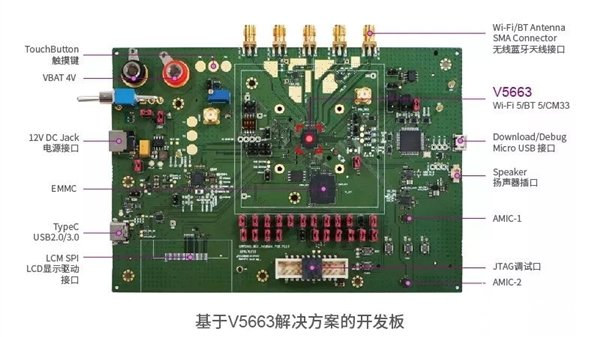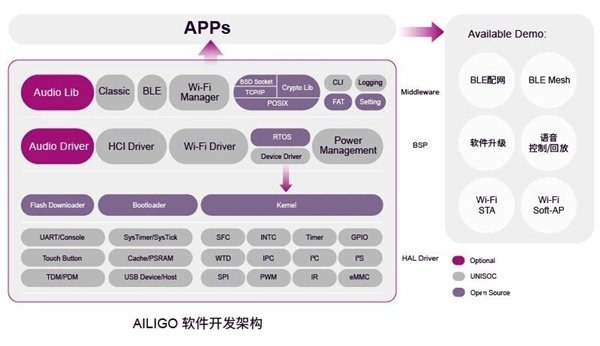UNISOC has launched a new processor for AIoT (Artificial Intelligence + IoT) applications with V5663 dual-core Cortex-M33 processor, supports for dual-band WiFi 5, Bluetooth 5.1, and audio features such as a voice activity detector and microphone array support which should make it ideal for smart speakers, and other smart audio applications.
 UNISOC V5663 WiSoC specifications:
UNISOC V5663 WiSoC specifications:
- CPU
- Arm Cortex-M33 processor @ 442 MHz with TrustZone, 32KB I-cache, 32KB D-Cache for application code
- Arm Cortex-M33 processor @ 416 MHz for WiFI and Bluetooth
- Memory – Built-in SRAM + external PSRAM interface
- Storage – eMMC, SDXC interfaces
- Connectivity –
- Dual-band 802.11 b/g/n/ac WiFi 5 2×2 MIMO
- Bluetooth 5.1 dual-mode (Classic + LE)
- Mesh Networking for WiFi and Bluetooth
- Indoor Positioning – WiFi RTT, Bluetooth direction finding (AoD / AoA)
- Audio – Voice Activity Detector (VAD), PDM and I2S/PCM interfaces
- Peripherals:
- USB 2.0 / 3.0, eMMC
- I2C, SPI, HS SPI, UART
- GPIO, PWM
- IR
- Touch and push-button interfaces
- Aux ADC
- Debugging – JTAG
- Security – Crypto Acceleration, eFuse, ARM PSA security architecture certification: PSA Level 1, on-going PSA Level 2
- Manufacturing – 22nm process
 The company also designed a V5663 evaluation/development board with five antennas, two built-in microphones, a speaker connector, a USB-C interface, and an SPI LCD interface, plus some touch buttons. Power appears to be delivered either through a 12V DC jack or external 4V battery.
The company also designed a V5663 evaluation/development board with five antennas, two built-in microphones, a speaker connector, a USB-C interface, and an SPI LCD interface, plus some touch buttons. Power appears to be delivered either through a 12V DC jack or external 4V battery.
UNISOC also worked on AILIGO development framework for the processor/board and will launch a community in the next few weeks. The framework is based on an RTOS (FreeRTOS?) with a communication stack, audio library and driver, power management. and so on.
 The diagram above also reveals several Bluetooth and WiFi sample code/demos will be part of the SDK. Somehow the audio libraries are optional, so they may charge extra for those, and it also looks like only select components will be open source.
The diagram above also reveals several Bluetooth and WiFi sample code/demos will be part of the SDK. Somehow the audio libraries are optional, so they may charge extra for those, and it also looks like only select components will be open source.
There’s no product page that I could find at this stage. It’s not the first WiFi 5 + Bluetooth 5 processor from the company, as we previously covered IVY5661 board following 96Boards IoT Edition specifications.
Via Elecfans and AnalogLamb

Jean-Luc started CNX Software in 2010 as a part-time endeavor, before quitting his job as a software engineering manager, and starting to write daily news, and reviews full time later in 2011.
Support CNX Software! Donate via cryptocurrencies, become a Patron on Patreon, or purchase goods on Amazon or Aliexpress





It is an overgrown ESP32. They should market it like one.
true. Question is: Will it be as cheap as the ESP32?
>It is an overgrown ESP32
mm not sure on that. On paper it looks a lot more capable and less weird than the ESP32.
Yes, it *looks*. But what makes ESP32’s success is its widely available SDK associated with cheap & small modules that are easy to integrate and program in field.
The SDK will be a train wreck like they all are but the specs of the hardware *seem* much better than the ESP32. It seems to be trying to fill the spot where an MCU is a bit wimpy but something like a i.mx6ull is too expensive.
FYI Marvell IoT SDK, Cypress’ WICED SDK etc are publicly available. You can’t really get parts to run them without having access to the NDA’d versions of them so it’s basically useless. It would be interesting to see how the sales numbers for the ESP32 modules compare to something like the Murata type 1GC. I think outside of the maker community they probably aren’t out selling the more established vendors.
Espressif is a publicly traded company with a market cap of over $2B. Based on their revenue numbers I suspect they are selling around 500M ESP32s in a year. Most of these sales are inside China.
Murata is a $40B company.
I suspect a new non-name company like Espressif was a few years ago for most of us has more chances to succeed in this fast moving than a well established one like Marvell, Cypress, Realtek or any other one, just because 1) they can dedicate 100% of the effort on a single direction, and 2) all you need to remember to spread the word is either the company’s name or the chip’s short name (since the company has few products). Assembling a community around a new techno really requires something that is extremely easy to identify. Espressif succeeded in this are, and probably a bit by accident at the beginning, but ESP8266 quickly became the name of a technology and of a way to address certain problems more than that of a chip. The other ones do so many distinct things it’s impossible to stay up to date. I didn’t even know Marvell did IoT eventhough I follow their products (and in addition they’re totally paranoid by wanting you to sign NDAs for everything, in order to be certain you will pass your way and never have the ability to fix their bugs to make their products better).
>I suspect a new non-name company like Espressif
I think most of the points you make apply for the maker/hobbyist segment but not for the general industry outside of China.
>I didn’t even know Marvell did IoT
They canned it a while back. NXP has bought their wireless stuff now too so Marvell are totally out of the game.
>in order to be certain you will pass your way and never have the
>ability to fix their bugs to make their products better).
Nope. They provided the whole SDK source to customers apart from some stuff like homekit. I fixed/reported a bunch of issues in the SDK to Marvell which were incorporated in later SDK releases. Same deal for WICED.
The Cortex ‘M3’ in the first paragraph threw me off. Of course you meant ‘M33’.